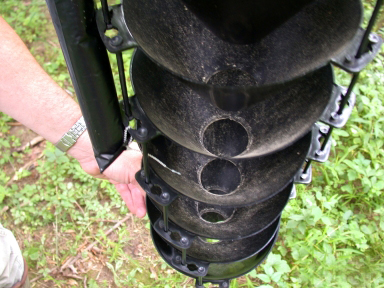Information Forestry, December 2007—Many insects rely on scent to communicate with each other and to find food and hosts. Setting out traps baited with insect and host-tree smells has long been a technique used by plant health officials to detect and track unwanted pests.
But the scents currently used by the Canadian Food Inspection Agency (CFIA), the federal organization responsible for keeping Canada’s forests safe from alien forest pests, fail to entice all insects of potential concern into detection traps. For instance, baited traps have yet to consistently capture emerald ash borer or Asian longhorned beetle, two non-native insect species infesting regions of southern Ontario. Scientists at Natural Resources Canada are helping the CFIA close these gaps by testing new lures and scent combinations.
“Right now, we’re quantifying what species the lures are picking up and what species they’re missing,” says Canadian Forest Service Entomologist Lee Humble, from the Pacific Forestry Centre. “Our goal is to develop more generic lures and extend the repertoire of lures used to trap nonnative insects that may have already become established in Canada.”

Plant-protection officials set out insect traps baited with scents that attract beetle and moth species to detect and monitor the presence of forest pests. Canadian Forest Service researchers are trying to determine the most effective scents and scent combinations to lure non-native wood-boring and bark beetles into traps.
The researchers are testing combinations of scents released by common host trees, in addition to insect pheromones—scents released by insects that prompt behaviours in other members of the same species.
“Pheromones target specific species or groups of species, and are usually much more sensitive than host-tree compounds,” says Atlantic Forestry Centre Research Scientist Jon Sweeney. “A target insect encounters it, and it responds like, ‘hey, there’s one of me out there calling, and it’s saying let’s get together.’”
But pheromones limit the range of insects detected. “By including a pheromone in your trapping system, you increase sensitivity or detection ability for a particular pest, but you also narrow the focus of that lure,” Sweeney says. “It simply won’t work on a broader range of species.”
“There are hundreds or thousands of insects we don’t want entering this country,” says Peter deGroot, a research scientist with Great Lakes Forestry Centre. “You can put species-specific pheromones out, but it becomes very cumbersome to place and maintain hundreds of traps, each with a different pheromone for a different insect. And in many cases, we don’t have the pheromones, and we have to rely on other things to attract the insect into an area and into a trap.”
Lures based on tree scents, which include ethanol and components of turpentine, entice broader ranges of insect species by mimicking stressed or injured trees—the preferred targets of most wood- and bark-boring insects.
“Determining a suite of lures that attracts a broad range of species is a way to lower the risk of infestation by a non-native pest,” says deGroot. “It helps us find and counter insect problems before they blow up so big we can’t eradicate them.”
Humble, Sweeney and deGroot began testing in 2006. They placed lures at sites in Nova Scotia, Vancouver and southern Ontario that are considered high risk for introductions of alien forest insects. Sites include ports, freight depots, and warehouses. The scientists are documenting and analyzing results collected during the last two years, and will be setting out test traps again in 2008.
© Natural Resources Canada 2007





